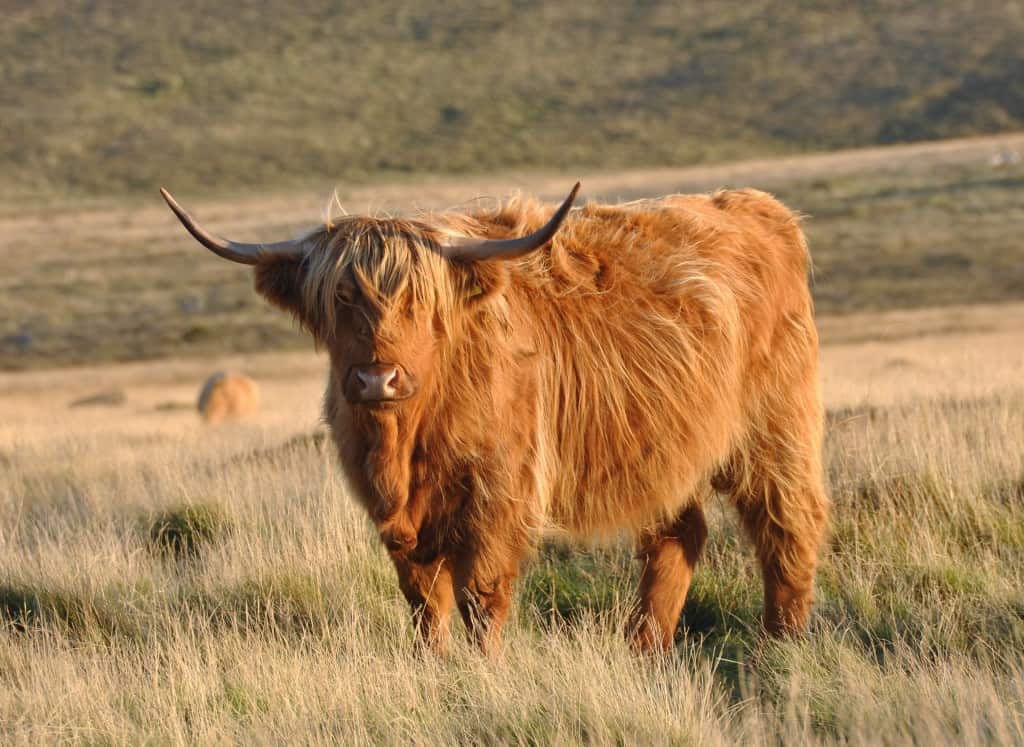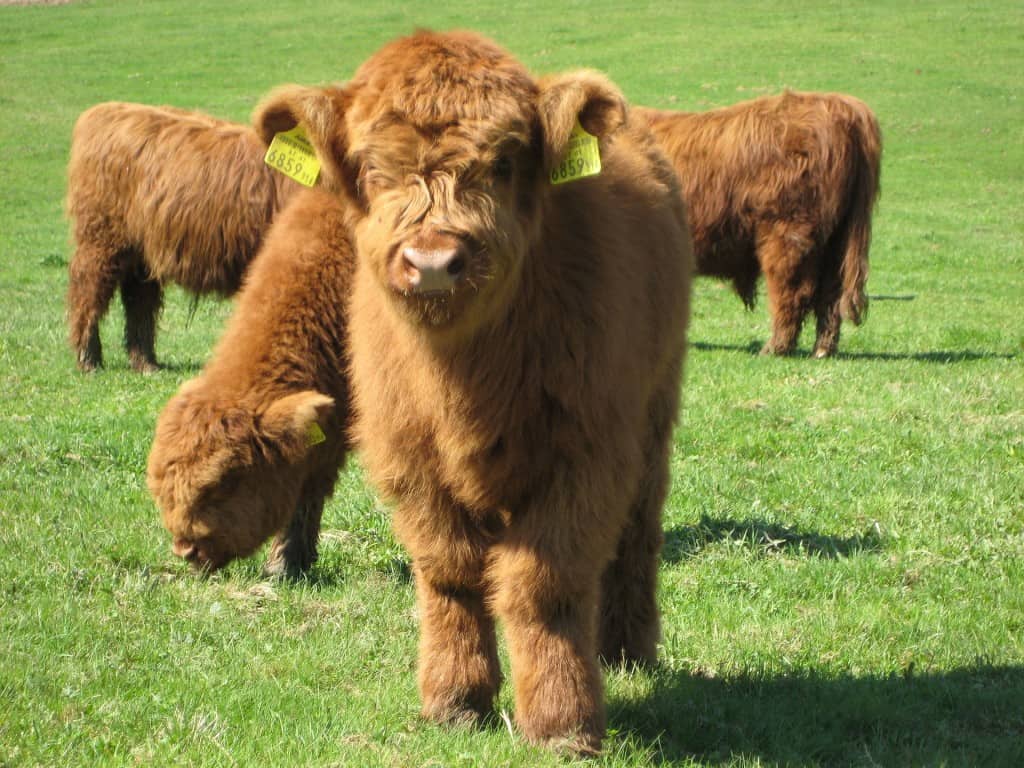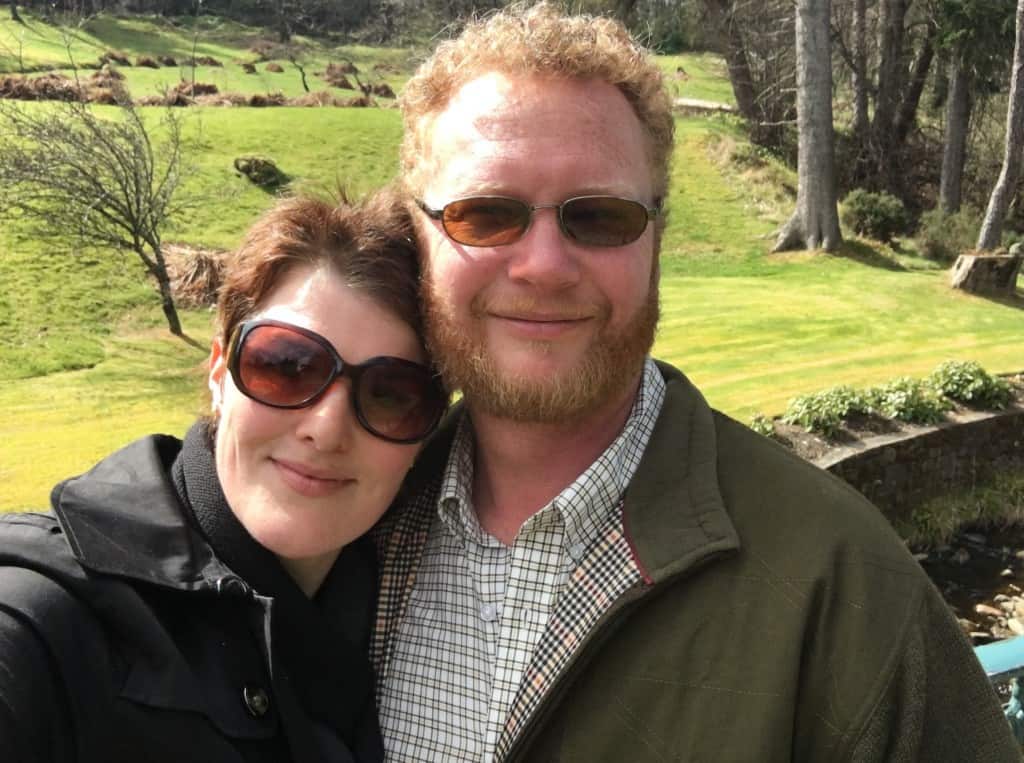The typical urban homesteading wish list for animals looks like this: chickens, meat rabbits, bees, milk goats.
Well, I have the chickens and a few ducks. But the one animal I really covet? Scottish Highland Cattle. Look at them. Just look at them! Have you ever seen a more adorable bovine?
 Image by Nilfanion (own work) CC BY-SA 3.0 or GFDL, via Wikimedia Commons
Image by Nilfanion (own work) CC BY-SA 3.0 or GFDL, via Wikimedia Commons
And the babies? Squee! They are like a labradoodle in cow form. How can anyone not want a baker’s dozen of those?
 Image by Aconcagua (own work), CC BY-SA 3.0, via Wikimedia Commons
Image by Aconcagua (own work), CC BY-SA 3.0, via Wikimedia Commons
Now I will admit that I am predisposed to like anything with shaggy, red, curly hair. You may notice that the Scottish Highland Cattle totally match my adorable, redheaded husband.
Look, here we are in Scotland. Nick with a Scottish Highland would be like that ad where dogs look exactly like their owners, right?

Although Highlands are a rare breed, interest and marketability around the globe has ensured a stable population and the breed isn’t considered immediately threatened.
The Livestock Conservancy lists, essentially, bureaucratic homogenization as the greatest threat to Highlands:
The European Union has issued directives requiring that all livestock herdbooks in member countries…be accorded recognition by herdbooks in other member countries. Many European herdbooks…will register animals with as little as three-fourths pure breeding as purebreds. If E.U. directives force the British studbook to become open to crossbred Highland cattle from Europe, then the consistency and purity of the breed will be reduced. The United States and Canada, whose closed herdbooks remain outside the jurisdiction of the E.U., may soon be the best reservoir of purebred Highland genetics in the world.
Since the UK recently triggered Article 50 to leave the European Union, the breeding lines of Highland Cattle in Scotland itself, and whatever herds might be maintained in England, Wales and Northern Ireland, will presumably be easier to preserve. That is, if an independant Scotland doesn’t try to join back up with the EU. In any event, what a fascinating lens through which to view modern geopolitics: possible impacts on the genetics of my favorite cattle breed.
Scottish Highland Cattle aren’t just a pretty face. As you’d expect, they’re a hardy, stocky, medium-size breed that does exceptionally well in cold, wet climates.
According to the interwebs, Scottish Highlands are competent, easy mothers, and develop beautifully on less than ideal pasture. In fact, because Highlands munch down pest plants as well as grass and don’t overly compact soil, they are particularly good for pasture improvement and regeneration.
Highlands give high-butterfat milk, and – if you manage not to adopt every single one as a pet – delicious, low-cholesterol meat. In Scotland we had the opportunity to…uh…taste test my favorite livestock animal, and the meat is incredible. Although to be fair, we found all Scottish beef (Scottish food in general, believe it or not) to be several notches above U.S. conventionally raised beef. (It’s the grass.)
And if all that isn’t enough to convince you, the breed has a permanent residence at Balmoral Castle, the residence for the Queen of England when she is in Scotland. So basically they are cow royalty.
So it’s settled. Scottish Highland Cattle are the perfect livestock animal.
If I ever went full-on farmer, I’d like to buy land in the Scottish Highlands and raise Scottish Highland Cattle. At the end of the day I’d drink Scottish Whisky and learn to play Scottish Bagpipes.
I’d slowly pick up a Scottish accent, and – if I studied very hard for many years – one day I might even be able to understand Glaswegian. In my spare time I would stack Scottish rocks up around my properly and yell, “Occupy the Antonine Wall!” very loudly.
It would be glorious.
13
That DOES sound glorious!
This is the breed the farmers in my co op raise. I can attest to the delicious meat. It’s a good thing I don’t have to raise them, because they’re so darn cute my family might go hungry. ?
Exactly! 😀
Oh yeah! This is one animal I would have if I were younger (I’m 70 this Sept.). As it is, I have Ancona ducks (I live in the cartoon network), Pilgrim geese (see previous notation) and meat rabbits that I don’t breed cause I hate butchering them and I don’t like the meat that much. The only thing that they do here is amuse me and poop. That poop is garden gold, so they earn their keep and they LOVE blackberry leaves. That gives me incentive to go out and “harvest” the 10 acres of blackberries that grow on this property!
I also tried the pond idea with the ducks and have had to rethink it. I have 10 hens and very tired drake who has only survived because he was the littlest one and is amazingly gentleman like – for a duck.
But as for the pond, it holds about 500 gals at the moment but I used regular pond liner which worked for almost 3 years till critters dug under it and chewed huge holes in it. I have a drain that runs downhill to the front yard and I was able to capture all that lovely nutrient rich water when I drained the pond. I only filled it once every couple of weeks in the summer because I’m on a spring system, but all winter they had fresh pond water every two days.
This year, I’m going to concrete in the pond and make it a bit shallower since we may be facing hotter, drier, longer summers and even with my rain water storage system, I probably won’t want to keep it filled all the time. Watering the greenhouse and gardens are a better use in dry spells.
Sorry to ramble on so, but I’m a big follower of your blog – and of course, I have your book, which I love. We are doing so many of the same things! I will now shut up.
I’ve seen a few of these beauties grazing near my home in Colorado. They were so cool, I had to look up what they were.
We lived on a farm in Scotland for a year and the neighbors raised these guys. We were always feeding them and must have a thousand pictures of them! They do have a miniature version, you know. Just sayin’…
I think about half of the photos we took on our trip to Scotland were of these cows (the rest were probably distilleries).
They are one of my favorites along with Norwegian Fjord Horses, https://en.wikipedia.org/wiki/Fjord_horse Now if I just had the room………
How interesting! If you talk to the cattlemen up here in Skagit County, they’ll tell you Scottish Highlanders have stringy meat and are hard to get rid of at auction. I wonder if it’s just the cows from one, poorly managed pasture that have skewed the reputation up here. I agree that they’re absolutely adorable.
Oh that’s fascinating. My experience with the meat in Scotland was totally positive – definitely wouldn’t describe it as stringy. I wonder what the difference might be? Well managed Skagit pasture should be plenty lush, right?
We have been purchasing beef from Scottish highland cattle for several years now. We started just ordering a 1/4 cow for us, but have expanded to ordering 1-2 whole cows for all the friends that want in on the delicious beef. I coordinate the ordering, cut/wrap, and pickup in exchange for all the “extras” no one else wants–organ meats and bones. Good deal for me from my point of view. So, so tasty!! Which reminds me, gotta go reserve my beef for this fall before it all sells out…
Just wanted to share my livestock obsession: Ouessant sheep. I live in Germany and a local wildlife/livestock park has these (and sells the lambs…omg i want some). The ewes stand about 18in at the shoulder, about the size of a large beagle, and the lambs are like kittens. They are the most adorable animal. Sweet tempered, hardy, good wool producers, small enough to easily pick up. The perfect size to keep in your backyard, and there are a few flocks in the US too. Here’s an article about them being used as lawnmowers in Paris (careful, the video plays automatically):
http://www.nytimes.com/2013/04/04/world/europe/sheep-tend-lawn-outside-city-archives-in-paris.html?_r=0
I’ll also add the Valais Blackneck goat. Maybe not as suitable for an urban farmstead, but it makes me smile to look at them. It’s like someone glued half a black goat to half a white goat.
https://en.wikipedia.org/wiki/Valais_Blackneck
You are right! They are the absolute cutest! In fact, when my daughter turning one, I decided that I needed to get her a stuffed one- and of course they didn’t exist anywhere nearby, so I imported one via ebay. 🙂 They are my favorite ones to see at the fair too!
I have several friends with these cattle. I’m not as enamored with them as I was before I met them in person. I went the Dexter route, and even that was, erm, quite the experience.
They’re sure tasty int he freezer, though!
They seem even cuter (if possible) if you call them “hairy coo” as my daughter was doing after her year abroad! And yes, she was equally obsessed (I’m almost afraid to ask if she saw the babies)!
Ahhh, they are soooo cute, although I am partial to American Bison =) You sure can’t milk them, though!!